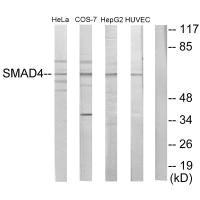
Western blot analysis of extracts from HeLa cells, COS-7 cells, HepG2 cells and HUVEC cells, using Smad4 antibody.
SMAD4 Antibody

CSB-PA825890
ApplicationsWestern Blot, ELISA
Product group Antibodies
ReactivityHuman
TargetSMAD4
Overview
- SupplierCusabio
- Product NameSMAD4 Antibody
- Delivery Days Customer20
- ApplicationsWestern Blot, ELISA
- CertificationResearch Use Only
- ClonalityPolyclonal
- ConjugateUnconjugated
- FormulationLiquid
- Gene ID4089
- Target nameSMAD4
- Target descriptionSMAD family member 4
- Target synonymsdeleted in pancreatic carcinoma locus 4; deletion target in pancreatic carcinoma 4; DPC4; JIP; MAD homolog 4; MADH4; mothers against decapentaplegic homolog 4; mothers against decapentaplegic, Drosophila, homolog of, 4; MYHRS; SMAD, mothers against DPP homolog 4
- HostRabbit
- IsotypeIgG
- Protein IDQ13485
- Protein NameMothers against decapentaplegic homolog 4
- Scientific DescriptionIn muscle physiology, plays a central role in the balance between atrophy and hypertrophy. When recruited by MSTN, promotes atrophy response via phosphorylated SMAD2/4. MSTN decrease causes SMAD4 release and subsequent recruitment by the BMP pathway to promote hypertrophy via phosphorylated SMAD1/5/8 By similarity. Common SMAD (co-SMAD) is the coactivator and mediator of signal transduction by TGF-beta (transforming growth factor). Component of the heterotrimeric SMAD2/SMAD3-SMAD4 complex that forms in the nucleus and is required for the TGF-mediated signaling. Promotes binding of the SMAD2/SMAD4/FAST-1 complex to DNA and provides an activation function required for SMAD1 or SMAD2 to stimulate transcription. Component of the multimeric SMAD3/SMAD4/JUN/FOS complex which forms at the AP1 promoter site; required for syngernistic transcriptional activity in response to TGF-beta. May act as a tumor suppressor. Positively regulates PDPK1 kinase activity by stimulating its dissociation from the 14-3-3 protein YWHAQ which acts as a negative regulator. Hahn S.A., Science 271:350-353(1996). Zhang Y., Nature 383:168-172(1996). Moskaluk C.A., Diagn. Mol. Pathol. 6:85-90(1997).
- ReactivityHuman
- Storage Instruction-20°C or -80°C
- UNSPSC12352203
